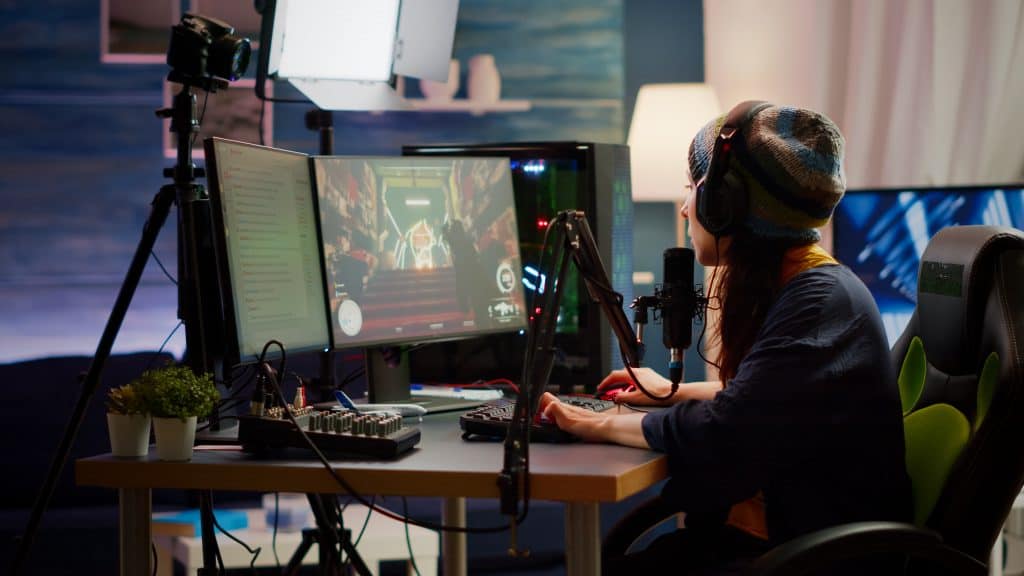From Pizza Boxes to RGB Thrones
If you grew up gaming in the 90s or early 2000s, you probably remember the classic “setup.” A chunky CRT monitor, a squeaky office chair, tangled controller wires, and maybe a half-empty bag of Doritos serving as desk décor. Back then, gaming spaces weren’t about aesthetics — they were about function. You had what you needed to play, and that was that.
Fast-forward to today and the transformation is almost unrecognizable. Open Reddit’s r/battlestations, browse YouTube gaming tours, or scroll TikTok, and you’ll see desks that look more like art exhibits than utility stations. Neon RGB strips glow under ultrawide monitors, anime figures stand guard by keyboards, and giant themed mouse pads sprawl across desks like digital red carpets.
Gaming setups have evolved from messy utility corners into shrines of fandom, identity, and creativity. And the story of how we got here is as fascinating as the setups themselves.
From Utility to Identity
The earliest PC and console setups were humble and utilitarian. Desks were cluttered not because it was “aesthetic,” but because there wasn’t another option. The focus was on performance — having a machine powerful enough to run DOOM, Quake, or StarCraft, not on whether your desk matched your vibe.
But then came the social shift. LAN parties in the early 2000s brought gamers together, and suddenly setups weren’t just private corners — they were shared spaces. By the 2010s, YouTube Let’s Plays and Twitch streams turned personal gaming desks into public stages.
When thousands of people are watching you game, your background and desk matter. A bland beige setup didn’t cut it anymore. Identity began to matter as much as performance. Gamers wanted their setups to say something about who they were.
The Rise of the Battlestation
Enter the “battlestation” era. Reddit communities like r/battlestations made setups into a subculture of their own. Entire threads were devoted to cable management, RGB synchronization, and the quest for the perfect ergonomic chair.
Manufacturers noticed. Gaming gear exploded beyond keyboards and mice into desks, chairs, lighting kits, and wall panels. Companies realized that gamers didn’t just want gear that worked — they wanted gear that looked good on camera.
The battlestation became the ultimate personal project. Some went minimal: all-white setups with sleek lines. Others went maximalist: walls covered in posters, neon lights, and collectibles. But the underlying truth was the same — your desk wasn’t just a place to play anymore. It was your digital throne room.
Fandom Takes Over the Desk
This is where geek culture truly fused with setups. Posters, Funko Pops, and figures have long been ways to show fandom, but fans wanted more than just display pieces. They wanted functional fandom — items they could use every day.
That’s why the desk became the new frontier. Suddenly, anime keycaps, themed controllers, and custom desk mats became must-haves. Why? Because unlike a poster that you look at occasionally, a desk mat is with you for every second of gameplay.
That’s why many gamers now choose custom anime mouse pads. They’re not just accessories — they’re cultural statements. Fans can pick designs that reflect their favorite series while still enjoying the smooth surface and pro-level performance needed for gaming.
Websites like Anichan are part of this shift, helping fans bring anime off the shelf and onto the desk. Whether you’re working from home, streaming, or just gaming late at night, your setup can be as much a reflection of your fandom as the posters on your wall.
Geek Shrines: Blurring Work and Play
The COVID-19 pandemic accelerated this evolution. Suddenly, desks weren’t just gaming spaces — they were offices, classrooms, and social hubs. Millions of fans who had never cared about setup aesthetics before started upgrading, not just for gaming, but for Zoom calls and sanity.
This blurred the line between “workspace” and “play space.” Fans decorated their desks not just to look cool, but to feel inspired while working from home. An anime desk mat wasn’t just a gaming accessory anymore — it was a way to bring joy into daily life.
We started seeing entire themed desks:
- A Naruto battlestation with orange highlights, kunai replicas, and anime mats.
- A Cyberpunk 2077 rig glowing neon pink and blue.
- Cozy Studio Ghibli desks filled with plants, Totoro figures, and wood-toned gear.
These setups aren’t just “desks” anymore. They’re shrines to fandom, crafted carefully to inspire and comfort their owners.
The Future of Gaming Setups
So, what’s next? The evolution of setups is still in motion. Here’s what’s on the horizon:
- AI Customization: Imagine AI-generated anime art that changes daily on your wall panels or desk mat.
- Smart Desks: Height-adjustable surfaces with built-in wireless charging, customizable lighting, and interactive displays.
- Limited Drops: Just like sneakers, gaming desk gear will move more toward exclusive runs and collabs — think seasonal anime desk pads or crossover mouse mats.
- Immersive Rooms: Desks won’t be standalone — the entire room becomes the setup, blending AR/VR and décor into a fully personalized geek space.
The shrine will grow larger, more personal, and more immersive. And anime, comics, and geek aesthetics will continue to lead the way.
Conclusion: Desks as Shrines of Fandom
From the dusty CRT corners of the past to today’s RGB-lit battlestations, gaming setups have evolved dramatically. They’ve shifted from pure utility to powerful statements of identity. And more than that, they’ve become shrines to fandom — places where culture, personality, and creativity collide.
The desk is no longer just a place to sit and play. It’s where your passions live, where your fandom is on display, and where your creativity shines. Whether you’re repping Demon Slayer, Naruto, or just your favorite RGB color scheme, your setup tells the world who you are.
And in the end, that’s what makes today’s gaming desks so much more than just furniture — they’re the shrines of modern geek culture.
Caroline is doing her graduation in IT from the University of South California but keens to work as a freelance blogger. She loves to write on the latest information about IoT, technology, and business. She has innovative ideas and shares her experience with her readers.






![‘Frankenstein’ Review – Guillermo del Toro’s Definitive Look At The Nature And Nurture Of Monstrosity [TIFF 2025] ‘Frankenstein’ Review – Guillermo del Toro’s Definitive Look At The Nature And Nurture Of Monstrosity [TIFF 2025]](https://cdn.geekvibesnation.com/wp-media-folder-geek-vibes-nation/wp-content/uploads/2025/10/Frankenstein-175_PF_20240430_20377_R-300x200.jpg)